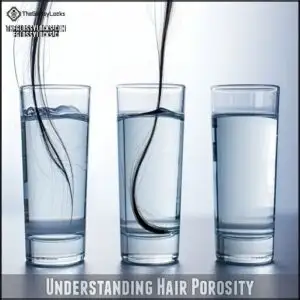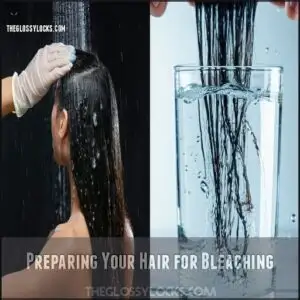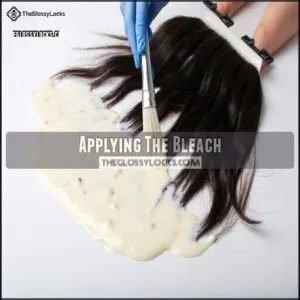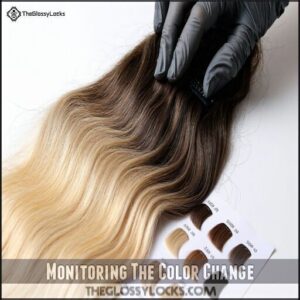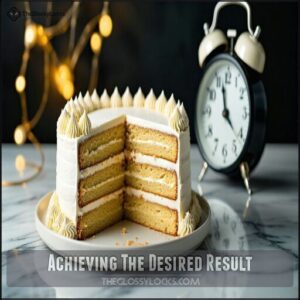This site is supported by our readers. We may earn a commission, at no cost to you, if you purchase through links.

The 20 volume gives you 1-2 levels of lift – perfect for subtle changes without wrecking your strands.
Meanwhile, 30 volume works faster with 2-3 levels of lift, but it’s more like playing with fire on your scalp.
Your hair’s porosity matters too; highly porous hair will soak up developer like a sponge.
Remember to check your progress every 5-10 minutes – those orange tones can sneak up faster than you’d think, and it’s crucial to avoid unwanted results by monitoring the lifting process closely.
Table Of Contents
- Key Takeaways
- Understanding Hair Porosity
- Choosing The Right Developer
- How to Bleach Your Hair
- Timing and Monitoring The Lightening Process
- Achieving The Desired Result
- Frequently Asked Questions (FAQs)
- Should I use 20 or 30 developer to lighten hair?
- How long should I leave 30% developer in my hair to lighten it?
- What can I mix with 20 volume developer to lighten my hair?
- What happens if you just put 30% developer in your hair?
- How long should I leave the bleach on my hair?
- Is it possible to lighten my hair without using bleach?
- What should I do if my hair turns out too orange after bleaching?
- Can I mix different developer volumes together?
- How long does developer-lightened hair color last?
- Will developer damage my previously color-treated hair?
- Conclusion
Key Takeaways
- Your hair’s porosity level directly affects how quickly developer works—test it by dropping a strand in water to see if it sinks (high porosity), floats in the middle (normal porosity), or stays on top (low porosity).
- Choose 20 volume developer for gentle 1-2 levels of lift with less damage, while 30 volume works faster with 2-3 levels of lift but increases the risk of damage.
- Always section your hair properly before applying bleach, starting from the back and leaving roots for last since your scalp’s natural heat speeds up processing time.
- Monitor your hair every 5-10 minutes during the lightening process and never leave bleach on longer than 30 minutes, even if you haven’t reached your desired shade.
Understanding Hair Porosity
Your hair’s porosity affects how quickly it’ll absorb developer and bleach, making it a key factor to check before you start your lightening journey.
You can easily test your hair’s porosity at home by dropping a strand in water and watching if it sinks quickly (high porosity), floats in the middle (normal porosity), or stays on top (low porosity).
What is Hair Porosity?
Your hair porosity is like your hair’s personal ID card – it determines how your strands interact with everything from moisture to hair color products.
Your hair porosity is your strands’ personal ID card—it determines how they’ll interact with everything from moisture to color.
Think of porosity as your hair’s ability to absorb and retain moisture and chemicals.
- Low porosity: Your hair cuticles lie flat and tight, resisting product absorption and making lightening more challenging with 20 volume developer
- Normal porosity: The sweet spot where hair accepts moisture evenly, ideal for balanced results with either 20 or 30 volume developer
- High porosity: Your cuticles are more open, quickly absorbing products but potentially causing damage when using 30 volume developer
- Damaged porosity: Over-processed hair that’s highly vulnerable to further damage
It helps you choose between 20 and 30 volume developers based on how your hair will actually respond, not just what color you want, considering the ability to absorb and the potential for further damage.
This knowledge is key to preventing damage and ensuring your hair receives the right treatment for its specific porosity needs.
Hair Porosity Test
Now that you understand what hair porosity is, let’s figure out yours with a simple test.
The Float Test is the easiest way to check your hair porosity levels. Here’s how:
Porosity Levels Behavior What It Means
Can’t wait for water to dry? Try the Spray Bottle method for quick Strand Assessment. Just mist clean hair and watch—does it bead up (low porosity) or disappear (high)?
Visual Inspection works too! Smooth, shiny hair usually indicates low porosity, while frizzy, dull strands suggest high porosity. Understanding your hair’s porosity helps in selecting appropriate products, because genetics affect porosity.
Choosing The Right Developer
You’ll need to pick the right developer strength for your hair lightening journey, just like choosing the right tool for any job.
The difference between 20 and 30 volume can mean the difference between subtly sun-kissed strands and a dramatic transformation that’ll make your friends do a double-take.
Differences Between 20 and 30 Volume Developer
The developer decision-making dilemma comes down to understanding lifting power and damage potential when choosing between 20 and 30 volume options.
The volume developer choice isn’t just about strength—it’s the balance between transformation power and protecting your precious strands.
- Lifting Power: 20 volume developer provides gentler color deposit with 1-2 levels of lift, while 30 volume developer delivers more dramatic results with 2-3 levels of lightening.
- Processing Time: Think of 20 volume as the scenic route—it works more gradually but with less damage. 30 volume is the express lane—faster results but requires constant monitoring.
- Hair Type Considerations: Fine or damaged hair? Stick with 20 volume. Resistant or very dark hair? 30 volume might be your answer.
- Developer Strength Trade-offs: Higher developer levels mean faster results but increased damage potential. Remember, your hair’s porosity affects how quickly it processes—high porosity hair absorbs developer faster, so adjust accordingly. To achieve the best results, opening hair cuticles is essential for color penetration.
Choose your developer strength wisely based on your lightening goals!
What to Use Instead of Drugstore Box Dye
While 20 and 30 volume developers each have their merits, what you mix them with matters just as much.
Ditch those drugstore box dyes! They’re notorious for uneven results and unnecessary damage.
Instead, invest in salon-quality dyes like Wella, Redken, or Schwarzkopf that offer custom formulations with superior ingredient quality.
Professional products contain conditioning agents that minimize damage during hair lightening. Your stylist can recommend the perfect combination based on your hair type—whether you need gentle 20 volume for fine strands or stronger 30 volume for stubborn color.
For the health-conscious, try demi-permanent options that deposit color without harsh chemicals. Your hair’s future self will thank you!
How to Bleach Your Hair
You’ll need to properly prepare and section your hair before mixing your chosen developer with bleach powder for that dramatic color transformation.
When you apply the mixture starting from the back sections and ending with your roots, you’re setting yourself up for the even, professional-looking results.
This approach helps ensure that you won’t leave you looking like you stuck your finger in an electrical socket, achieving a more professional-looking finish.
Preparing Your Hair for Bleaching
Before diving into the bleaching process, proper preparation makes all the difference between damaged hair and stunning results.
Now that you’ve selected your developer, let’s get your strands ready for their transformation.
Preparing your hair properly involves four key steps:
- Start with a clarifying shampoo 2-3 days before bleaching to remove product buildup that can interfere with even lightening.
- Deep condition regularly for at least a week prior to boost moisture balance and strengthen your strands.
- Perform a porosity test by placing a strand in water – how quickly it sinks determines how your hair will react to bleach.
- Complete a strand test with your chosen developer to preview results and avoid unwanted surprises.
Using a specialized hair product can improve results.
Remember: always bleach completely dry hair for even results!
Sectioning Your Hair for Even Application
Before diving into the bleaching process, proper sectioning is your secret weapon for flawless results. Divide your hair into four distinct sections—create a middle part from forehead to nape, then make a horizontal division above each ear. Secure each section with sturdy clips for maximum control during application.
This strategic hair partitioning prevents overlap and guarantees even distribution of product. Always work from back sections forward, as the nape area processes slower than front strands. Even color distribution is a key benefit of this technique.
Think of sectioning patterns as your roadmap to perfection—neat divisions mean more precise application. Essential tools include a tail comb for clean partitioning and sectioning clips that won’t slip during the process. Proper sectioning is crucial for achieving flawless results and ensuring that your hair receives an even application of the product, which is key to a successful hair coloring process.
Applying The Bleach
Grab your tint brush and let’s tackle bleach application with confidence. Creating the perfect bleach mixture is essential for even results.
Apply to small, manageable sections starting about an inch away from your scalp, as natural heat accelerates processing time.
- Mix bleach to a yogurt-like consistency for ideal control and even distribution
- Work methodically from back to front, avoiding overlap on previously applied sections
- Save roots for last—they process faster due to scalp heat (I learned this the hard way!)
For superior results, consider specific product options.
For safer at-home bleaching, stick with 20 volume developer instead of the more aggressive 30 volume. Your hair will thank you for the gentler approach while still achieving that lighter look you’re after.
Timing and Monitoring The Lightening Process
You’ll need to watch your hair like a hawk during the lightening process, as timing can make the difference between gorgeous blonde locks and a fried mess.
Your careful monitoring will help catch that perfect shade before your strands throw a chemical tantrum.
You should be aware that timing is crucial in this process.
How Long to Leave The Bleach On
Timing your bleach application correctly can make the difference between gorgeous locks and a hair disaster. The clock starts ticking the moment developer meets bleach!
| Developer Strength | Processing Time | Best For |
|---|---|---|
| 20 Volume (6%) | 30-45 minutes | Gentle lift, beginners |
| 30 Volume (9%) | 20-30 minutes | Faster results, darker hair |
| Roots | 15-20 minutes | Apply last due to scalp heat |
| Virgin Hair | 30 minutes max | First-time bleaching |
| Previously Dyed | 15-25 minutes | Varies by hair history |
Remember, a strand test beforehand saves you from guessing your hair lightening timing. Never exceed 30 minutes—after that, your bleach stops lifting color and starts damaging strands instead.
Watch for over-processing signs like excessive dryness or stretchy wet strands. When in doubt, use a color chart to track your progress through the developer processing time.
Monitoring The Color Change
The careful monitoring of your hair’s color change is essential for successful lightening.
Check your hair every 10-15 minutes against a color chart to track progress through different stages—from orange to pale yellow.
Remember, damaged sections will lighten faster due to higher porosity.
Regular visual assessment helps prevent over-processing and guarantees you stop at the right moment.
By understanding hair lightening levels and recognizing when to neutralize unwanted tones, you’ll achieve your desired shade without any bleach-related surprises.
Many people use natural hair lighteners for a gentler approach.
Achieving The Desired Result
You’ll know you’ve achieved your dream shade when your hair reaches the right level on the color chart, much like waiting for a cake to bake to golden perfection.
Your choice between 20 and 30 volume developer directly affects how quickly and effectively you’ll get there, so patience during monitoring pays off with results that won’t make you reach for a hat.
Understanding The Lightening Process
Watching your developer transform your dark locks is like witnessing chemistry in action.
The lightening process follows a predictable color journey as the developer activates and opens your hair cuticle.
Here’s what happens during melanin oxidation:
- Dark brown/black → deeper red (level 1-2 lift)
- Red → copper/orange (level 3-4 lift)
- Orange → brassy yellow (level 5-6 lift)
- Yellow → pale yellow/platinum (level 7-8 lift)
Your 20 volume developer takes this journey slowly, while 30 volume races through—sometimes too quickly for your hair’s good!
Dealing With Orange Tones
Understanding how color works doesn’t help much when you’re staring at orange hair in the mirror. Don’t panic – those brassy tones happen when your hair stops at the orange stage of lightening.
For mild brassiness, purple shampoo works wonders. For darker orange, reach for blue toner – it’s your best neutralizing orange partner. Simply apply following package directions.
For stubborn cases, a gentle bleach bath with 20 volume developer might be needed. The 30 volume developer delivers stronger correction but increases damage risk. Many turn to toners for orange hair to correct this issue.
Always do a strand test first! Proper toner selection and aftercare routine prevent brassiness from returning.
Frequently Asked Questions (FAQs)
Should I use 20 or 30 developer to lighten hair?
Just as a painter chooses brushes based on the canvas, pick your developer strength wisely.
Use 20 volume for gentle lifting (1-2 levels) or 30 volume for stronger results (2-3 levels) on healthy hair.
How long should I leave 30% developer in my hair to lighten it?
You shouldn’t leave 30% developer alone in your hair. If you’re using it with bleach, limit exposure to 15-20 minutes maximum. Always check frequently and rinse immediately if your scalp burns.
What can I mix with 20 volume developer to lighten my hair?
Mix your 20 volume developer with bleach powder for effective lightening. You can also use it with high-lift hair color or purple shampoo to tone while slightly lightening previously processed hair.
What happens if you just put 30% developer in your hair?
Using 30% developer alone will open your hair cuticle and lift color by 2-3 levels.
But it’ll damage your hair without depositing new color, which is risky and not recommended for healthy results.
How long should I leave the bleach on my hair?
Believe it or not, 7 out of 10 DIY colorists over-process their hair! You should leave bleach on for 20-30 minutes maximum, checking every 5-10 minutes to prevent damage. Never exceed 30 minutes.
Is it possible to lighten my hair without using bleach?
Yes, you can lighten your hair without bleach by using high-volume developer alone. A 30 or 40 volume developer will lift your color 1-2 levels, though results are more subtle than bleach.
What should I do if my hair turns out too orange after bleaching?
Your orange hair nightmare can be quickly fixed with a purple toner.
Apply it to neutralize brassy tones, then use blue-based shampoo regularly.
Deep condition afterward to keep your hair healthy.
Can I mix different developer volumes together?
You can mix developers to create custom volumes for specific needs.
For example, combining equal parts of 20 and 30 volume gives you 25 volume, offering a middle-ground lifting power with moderate damage risk.
How long does developer-lightened hair color last?
You’d think hair would stay pale forever! Your developer-lightened hair typically lasts 4-6 weeks before roots show. Color molecules gradually wash out with each shampoo, causing subtle fading over time.
Will developer damage my previously color-treated hair?
Developer can damage color-treated hair, especially at higher volumes.
Your previously processed strands are more porous and vulnerable to additional chemical processing.
Consider using lower volume developer and deep conditioning treatments to minimize harm.
Conclusion
Surprisingly, 85% of home hair-lightening mishaps happen from using the wrong developer strength.
Whether you choose 20 or 30 volume developer to lighten hair depends on your desired lift and hair’s condition.
Remember, this ultimate guide shows that gentler 20 volume works for subtle changes, while 30 volume delivers more dramatic results—but with greater risk.
Always test your hair’s porosity first and monitor closely, as your perfect blonde awaits, just choose your developer wisely!

